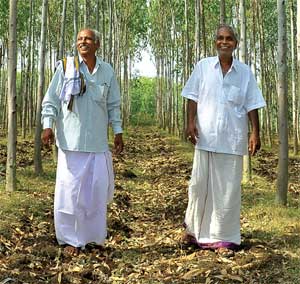Adaptation to Climate Change Impact through Diversification of Farming Systems
Wasteland Development:
Social Forestry
 The primary objective of the programme is to provide viable land-use options for degraded / marginal lands through the promotion of plantations, thus promoting sustainable livelihoods for poor farmers. The other positive spin-offs are groundwater recharge, soil conservation and carbon sequestration on a significant scale. To ensure the commercial viability of these plantations, ITC’s R&D Centre at Bhadrachalam developed site-specific clones that were high yielding and drought resistant. The primary objective of the programme is to provide viable land-use options for degraded / marginal lands through the promotion of plantations, thus promoting sustainable livelihoods for poor farmers. The other positive spin-offs are groundwater recharge, soil conservation and carbon sequestration on a significant scale. To ensure the commercial viability of these plantations, ITC’s R&D Centre at Bhadrachalam developed site-specific clones that were high yielding and drought resistant.
The area covered under the forestry programme during 2009-10 was 13,333 hectares taking the total to 1,03,466 hectares. Of this, the area under social forestry during the year was 2,082 hectares. 933 hectares was felled by 1,174 beneficiaries during the year, yielding 19,996 tonnes of debarked wood. The poor tribal farmers earned a gross income of Rs 3.60 crores at an average of Rs 31 thousand per farmer. The total village development corpus with the forest sanghas now stands at Rs 94 lakhs. To date, the Social Forestry programme has created sustainable livelihood opportunities for 19,376 poor households by transforming 16,442 hectares of land into productive plantations. In addition, it has augmented the raw material base for our paper business, contributed to carbon sequestration and has been registered for a CDM project, having a potential earning of 57,799 CER annually for 30 years. |
| |
Cum to 2008-09 |
2009-10 |
Cum to Date |
| Coverage |
|
|
|
| No of villages |
454 |
26 |
480 |
| No of beneficiaries |
16,061 |
3,315 |
19,376 |
| Plantation Area (Hectares) |
14,360 |
2,082 |
16,442 |
| Economic Impact |
|
|
|
| Harvest Area (Hectares) |
1,766 |
933 |
2,700 |
| Income to Farmers (Rs. In Lakhs) |
814 |
360 |
1,174 |
| Village Development Fund |
78 |
16 |
94 |
|


|
|

